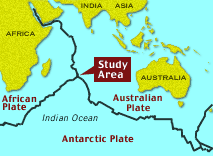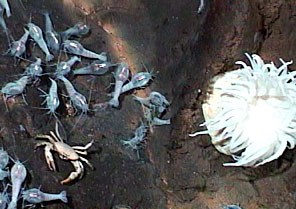|
Biologists always thought life required the Sun's energy, until
they found an ecosystem that thrives in complete darkness.
by
Patrick L.Barry
Dr. Cindy Van Dover manoeuvres her
robotic craft closer to the strange, rocky landscape below. It's
totally dark, except for lonely circles of light where she points
her flood lamps. Back on the mother ship her monitor reveals tall,
thin towers of craggy rock billowing black smoke from their peaks.
Very strange!
All around the towers stand dozens
of red-and-white, tube-like organisms. These bizarre, 3-foot-long,
wormish creatures have no mouth, no intestines, and no eyes. Stranger
still, they derive their energy from the planet itself, not from
the light of the nearby star -- a feat most biologists didn't believe
possible until these creatures were found.
She steers toward the worms and uses
the robotic arm to reach out and take a sample for later examination.
Is this a science fiction tale? No.
Is the intrepid Dr. Van Dover truly exploring another world? Yes!
Van Dover is as real as is the alien
world she's discovering. And both are right here are Earth!
Cindy Van Dover, a marine biology professor
at the College of William and Mary in Williamsburg, Virginia, is
one of some 60 scientists, technicians and sailors who sailed aboard
the research vessel Knorr from the Woods Hole Oceanographic
Institution between March 27th and May 5th 2001. This 40-day expedition
sent a 1-ton robotic submarine named JASON 2,000 metres down to
explore the peculiar sunless world of deep-sea hydrothermal vents.
 Images courtesy Woods Hole Oceanographic
Institution
Images courtesy Woods Hole Oceanographic
Institution A view of a "chimney" vent (top photo) captured
by the deep-sea submersible JASON. The superheated black water
pouring from the vent provides high-energy chemicals that
sustain the tubeworms (bottom photo) and other organisms that
thrive in this unlikely habitat.
|
"I really never thought that one could
be an explorer in this day and age," said Van Dover, chief scientist
for the expedition and a member of NASA's Astrobiology Institute.
"But in the ocean, it's absolutely true," she added. "You're going
places that nobody's ever been before!"
The hydrothermal vents - which are
essentially geysers on the sea floor - support exotic chemical-based
ecosystems. Some scientists think the vents are modern-day examples
of environments where life began on Earth billions of years ago.
And the vents might also hold clues to life on other planets.
The thriving communities of life that
surround these hydrothermal vents shocked the scientific world when
the first vent was discovered in 1977.
Before 1977, scientists believed that
all forms of life ultimately depended on the Sun for energy. For
all ecosystems then known to exist, plants or photosynthetic microbes
constituted the base of the food chain.
In contrast, these vent ecosystems
depend on microbes that tap into the chemical energy in the geyser
water that billows out from the sea floor -- energy that originates
within the Earth itself.
Because they offer an alternative way
for life to meet its fundamental need for energy, these vent ecosystems
have piqued the interest of astrobiologists - scientists who study
the plausibility of life starting elsewhere in the universe.
"It's the only system we know of on
Earth where life can thrive in the complete absence of sunlight,"
said Bob Vrijenhoek, senior scientist at the Monterey Bay Aquarium
Research Institute in Moss Landing, California. Vrijenhoek will
conduct DNA analysis on the samples gathered by the expedition.
One chore that astrobiologists have
struggled with for years is to define the range of conditions (temperature,
salinity, irradiation, chemical composition, etc.) in which "life
as we know it" could exist. The discovery of hydrothermal vent ecosystems
expanded that range.

Images courtesy Woods Hole Oceanographic Institution
The Study Area
|
"It (the life around the vents) was
the first discovery of 'life as we don't know it,'" Vrijenhoek said.
Hydrothermal vents form along mid-ocean
ridges, in places where the sea floor moves apart very slowly (6
to 18 cm per year) as magma wells up from below. (This is the engine
that drives Earth's tectonic plates apart, moving continents and
causing volcanic eruptions and earthquakes.) When cold ocean water
seeps through cracks in the sea floor to hot spots below, hydrothermal
vents belch a mineral-rich broth of scalding water. Sometimes, in
very hot vents, the emerging fluid turns black -- creating a "black
smoker" -- because dissolved sulphides of metals (iron, copper,
and several heavy metals) instantaneously precipitate out of solution
when they mix with the cold surrounding seawater.
Deep-sea bacteria form the base of
a varied food chain that includes shrimp, tubeworms, clams, fish,
crabs, and octopi. All of these animals must be adapted to endure
the extreme environment of the vents -- complete darkness; water
temperatures ranging from 2°C (in ambient seawater) to about 400°C
(at the vent openings); pressures hundreds of times that at sea
level; and high concentrations of sulphides and other noxious chemicals.

Images courtesy Woods Hole Oceanographic Institution
A variety of
animals live near these hydrothermal vents, including the
shrimps, crab, and anemone in this picture taken at the Indian
Ocean vent. So far, the hallmark red and white tubeworms have
not been spotted at this vent.
|
The ability of life to tap such geothermal
energy raises interesting possibilities for other worlds like Jupiter's
moon Europa, which probably harbour liquid water beneath its icy
surface. Europa is squeezed and stretched by gravitational forces
from Jupiter and the other Galilean satellites. Tidal friction heats
the interior of Europa possibly enough to maintain the solar system's
biggest ocean. Could similar hydrothermal vents in Europa's dark
seas fuel vent ecosystems like those found on Earth? The only way
to know is to go there and check.
Astrobiologists are increasingly convinced
that life on Earth itself might have started in the sulphurous cauldron
around hydrothermal vents. Vent environments minimise oxygen and
radiation, which can damage primitive molecules. Indeed, many of
the primordial molecules needed to jump-start life could have formed
in the subsurface from the interaction of rock and circulating hot
water driven by hydrothermal systems.
If this idea proves true, then the
next time Van Dover gazes through the submarine's camera at the
vents on the floor of the Indian Ocean, she may be seeing both a
portrait of life's genesis in Earth's distant past - and a glimpse
of alien life yet to be discovered.
The images in this story are courtesy
of Dive and Discover. Funded by
Woods Hole Oceanographic Institution, National Science Foundation,
Ohio's Centre of Science and Industry (COSI). Image courtesy of
shipboard scientists from College of William and Mary, Harvard University,
Monterey Bay Aquarium Research Institute, University of New Hampshire,
Oregon State University, Portland State University, University of
Washington, Woods Hole Oceanographic Institution.
|
